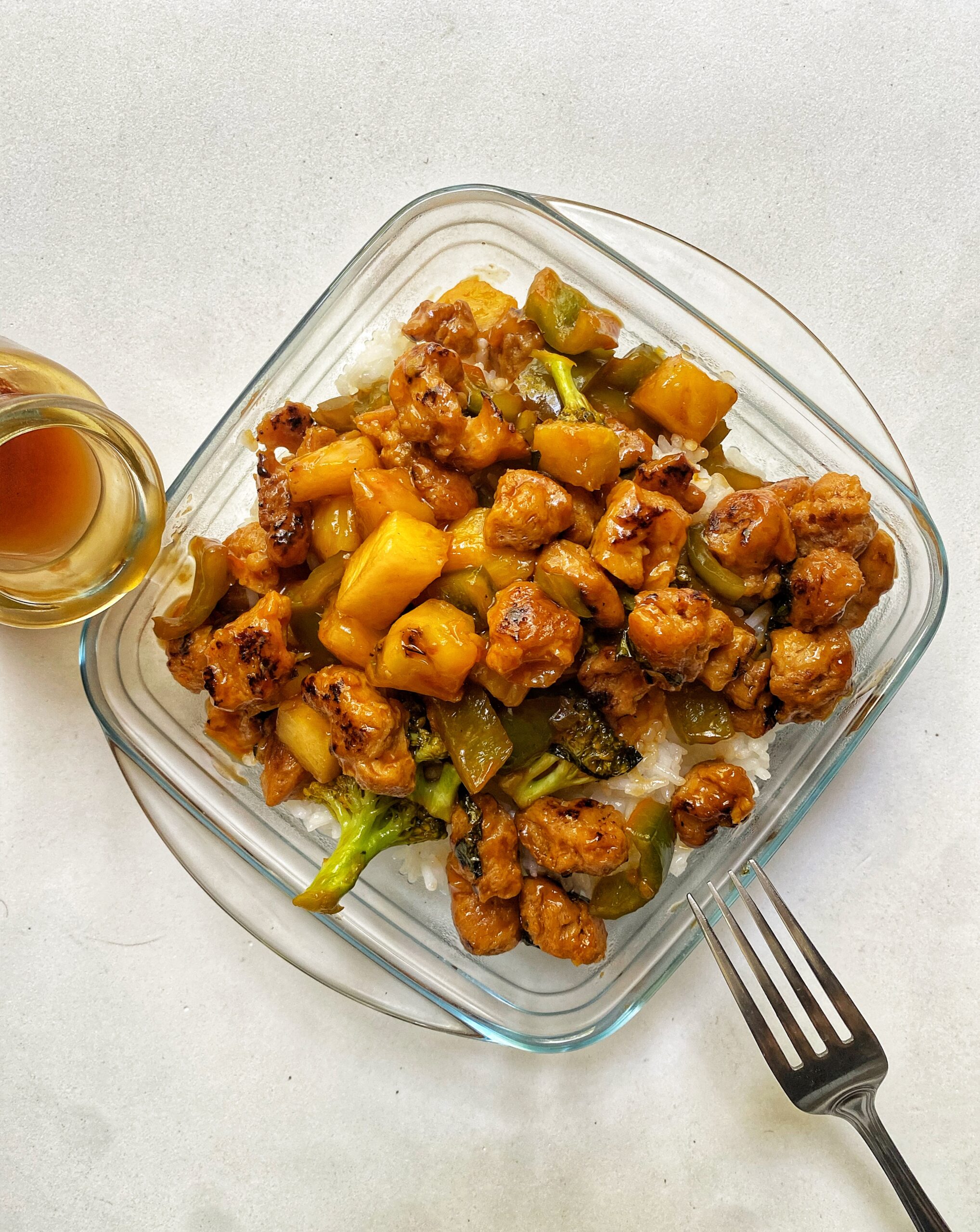Plork Pineapple Sweet’n’Sour with Rice

Today, we present you a fine chinese inspired vegan dish, using plant-based “pork” (soy chunks) as protein basis, pieces of fresh pineapple as the sweetness adding component, all combined with a delicious homemade Sweet and Sour Sauce and served on a simple rice.
Why sweet and sour?
Because it is so incredibly balanced, so incredibly good! Especially combinations with pineapple!
Historically seen, is sweet and sour not very young. The sweet and sour flavor combination dates back thousands of years, with evidence of its use in ancient Persia, China, and Rome. Early sweet and sour dishes were often made by combining honey or fruit with vinegar or fermented liquids, providing both sweetness and acidity. For example
- Ancient Persia: The Persian cuisine used fruits like pomegranates, prunes, and apricots along with vinegar to create sweet and sour sauces.
- Ancient China: Chinese cuisine developed sweet and sour flavors using ingredients like sugar or honey mixed with vinegar, soy sauce, and spices. The earliest records of such dishes come from the Tang Dynasty (618–907 AD).
- Ancient Rome: Roman cookbooks, such as “Apicius,” include recipes that blend fruits, honey, and vinegar to achieve sweet and sour flavors, often served with meats.
Development in Asian Cuisine
In China, the sweet and sour flavor became a staple in many regional cuisines. Cantonese cuisine, in particular, popularized dishes like sweet and sour pork – which is very similar to the veganized recipe presented here. This combined fried pork with a sauce made from vinegar, sugar, and ketchup or tomato paste. This dish has become iconic worldwide, especially through Chinese-American cuisine.
In Southeast Asia, the sweet and sour flavor is also prevalent, with dishes like Thai “pad pak ruam mit” (stir-fried mixed vegetables) or Vietnamese “canh chua” (sour soup), which combine tamarind or lime (for sourness) with sugar or pineapple for sweetness.
European Influence
In Europe, the concept of sweet and sour was also well-known, particularly in medieval times. The use of sweet and sour sauces was common in European courts, where chefs would combine fruits, vinegar, and spices. Over time, these dishes evolved and became less prominent as European cuisine shifted towards more distinct savory and sweet courses.
In the modern era, sweet and sour dishes have become globally popular, especially in the context of Chinese restaurants around the world. Today, sweet and sour dishes are enjoyed globally in various forms, from Asian-inspired dishes to Western adaptations. The balance of sweetness and acidity continues to appeal to a wide range of palates, making it a versatile and enduring flavor profile in global cuisine.
Sweet and sour pork – the original
Originally, sweet and sour pork is made by frying pork chunks coated with flour and egg. Often, they are double-fried, to enhance the crispiness. Only then, the assemblation is performed.
In our recipe, the substitute for pork (I simply call them “plork” for “plant-pork”), is kept very simply prepared. We only roast the soaked soy chunks in oil, which makes them slightly crispy, while keeping a certain juiciness. This turned out so fitting into the whole recipe!
Enjoy this delicious asian inspired vegan dish!

Plork Pineapple Sweet’n’Sour with Rice
Ingredients
- 1 cup soy chunks (or replace by 1/2-3/4 block bio tofu, if you cannot digest tvp products well)
- 1/2 cup rice
- 1 1/2 tsp fresh ginger, chopped
- 3/4 bell pepper, cut in pieces can be any colour
- 1 cup pineapple, cut in ca. 1 cm pieces
- 1 cup brokkoli florets
- 1/3 cup water
- 1 jar (250ml) homemade sweet and sour sauce see recipe link below
- oil for frying
Instructions
- If using tofu, skip this step!Soak the soy chunks in hot or warm water (you can use tap water) until nicely soaked (approximately 20 minutes).Drain the chunks well, squeeze out excess liquid, pat dry with kitchen paper if necessary.
- In a pot, wash the rice until the water turnes clear – drain the rice. Add a bit more than double of water to the washed rice, bring the water to a boil and cook the rice on low to medium heat, until the rice corns are nicely cooked (but still slightly crunchy in the middle). Drain any excess water if there is, close the pot with a lid and set aside.
- In a pan, fry the soy chunks (or the tofu, cut in cubes) in 2-3 tbsp oil until golden brown on all sides. Transfer the chunks onto a plate and set aside.
- In the same pan, sauté the ginger for a minute. Add the pepper and the brokkoli. Sautée for another 2 minutes. Add the pineapple. Continue to sautée.
- Once the ingredients have nicely produces flavor, add the water and let simmer until the water has evaporised.
- Now add the soy chunks and the sweet and sour sauce. If you wish more sauciness, add a few more tablespoons of water (optional). Coat everything well with the sauce and serve with the rice.
